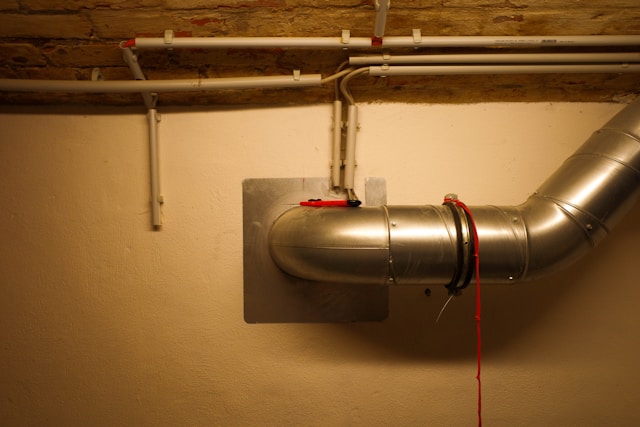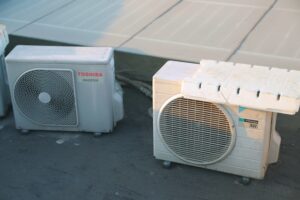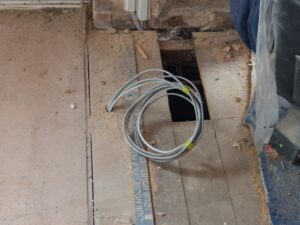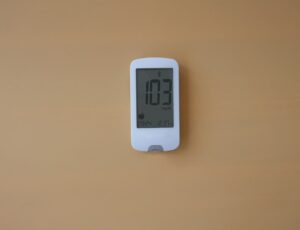A hot water heater leaking from the bottom might sound like a nightmare, but don’t panic!
Addressing the issue quickly can save you a lot of time, money, and frustration. The first step? Turn off the power to your water heater and stop the water supply—this simple move can help you prevent further damage.
But what’s causing this leak in the first place?
It could be a number of things, from a faulty valve to a corroded tank. Whether you choose to tackle the repair yourself or call in the pros, understanding the problem is key.
This is where Excel Mechanical comes in. We specialize in diagnosing and fixing issues like water heater leaks, ensuring your system operates safely and efficiently. We use top-quality tools and techniques to provide tailored solutions that fit your needs and budget, giving you peace of mind no matter how big or small the problem.
In this blog, you will learn:
- How to diagnose the source of a leak in your water heater.
- Immediate steps to take when you find a leak.
- Whether to repair or replace your leaking water heater.
Let’s get started!
Understanding Water Heater Leaks
Water heater leaks can be a hassle.
They often start at the bottom, where rust and sediment can build up over time. Common causes include rusty tanks and loose drain valves. A frequent sign is water pooling around the unit.
Before tackling a leak, ensure your safety.
Turn off the power supply. For electric heaters, switch off the circuit breaker. For gas models, set the gas control valve to “pilot.” Then, focus on your pressure relief valve. This small component helps manage excess pressure. If it’s malfunctioning, it might cause leaks. Check if it’s loose or damaged.
Inspect the area for visible cracks or corrosion, and if you notice any signs of a leak. Such damage can compromise your heater’s efficiency.
Common Causes of Leakage from the Bottom
A leaking water heater can be an alarming problem. There are several reasons why this might happen.
- Sediment Build-Up: Over time, minerals from your water can settle at the bottom of the tank. This sediment layer causes the tank to overheat, leading to potential leaks.
- Corrosion: Corrosion can eat away at your tank. If your tank is old, the metal might have rusted, weakening its structure and causing leaks.
- Loose Drain Valve: Your water heater has a drain valve to empty the tank. Water might escape from the bottom if this valve becomes loose or faulty.
- Temperature and Pressure Relief Valve (T&P Valve): The T&P valve releases excess pressure. If it’s leaking, there could be too much pressure inside the tank, or the valve could malfunction.
- Cracks in the Tank: With age and wear, the tank itself could crack. Even a small crack can become a big problem, allowing water to leak out from the bottom.
If you notice any of these issues, acting quickly is essential. Our team specializes in HVAC and plumbing services, offering quality and value for your home or business. Our team can assess and resolve your water heater problems, ensuring you have the best system for your needs.
Diagnosing the Source of the Leak
Identifying the source of a leak from your hot water heater is crucial to fixing the problem and preventing further damage. Focus on examining specific areas: the drain valve, the internal tank, and the temperature and pressure relief valve.
Each part can show unique issues that lead to leaks.
Drain Valve Issues
The drain valve is a common culprit when water pools at the bottom of your heater. This valve is responsible for letting you empty the tank for maintenance or repair. It can lead to leaks if it’s not fully closed or damaged.
You should check the valve to ensure it is tightly closed. If it continues to leak, even when secure, the valve might be faulty and need replacing. Sometimes, sediment build-up or corrosion can cause a poor seal, leading to leaks.
Replacing this part is often a straightforward fix you can do yourself if you follow proper safety protocols.
Internal Tank Failure
The internal tank can develop leaks due to corrosion, particularly if your water heater is old. Over time, minerals in the water can build up and cause the tank to corrode, leading to holes or cracks. This type of damage is often irreversible and may require a full unit replacement.
You should inspect the tank for signs of rust or water around the base. If you detect damage, it’s best to contact a professional service offering expert solutions in residential and commercial settings.
They can help determine the extent of the problem and advise on the most effective course of action.
Temperature and Pressure Relief Valve
The temperature and pressure relief valve is vital in preventing excessive pressure build-up in your heater. If this valve is faulty, it can leak water as a safety measure. Regular testing and maintenance can help ensure this part functions correctly.
Check to see if the valve is releasing water. This might be a normal function, but could also be a sign that the valve needs replacing. If you need to replace or fix it, consulting professionals ensures you get reliable and effective service tailored to your needs and budget.
Our commitment to quality and excellent service ensures your system remains safe and efficient.
Immediate Steps to Minimize Damage
When your water heater leaks from the bottom, acting quickly can help minimize damage.
1. Turn Off the Power:
- Electric Water Heater: Flip the breaker switch to off.
- Gas Water Heater: Turn the gas valve to the off position.
Make sure everything is safe before proceeding.
2. Shut Off the Water Supply: Locate the cold water valve, usually on top of the heater. Turn it clockwise to stop the water flow. This step prevents more water from leaking out and causing further damage.
3. Drain the Water Heater: Attach a garden hose to the drain valve at the bottom. Direct the other end to a nearby drain. Open the valve to let the water flow out safely. Be cautious, as the water might still be hot.
4. Clean Up Any Water: Use towels or a wet-dry vacuum to clean up any water spillage. This helps prevent damage to nearby floors or walls and reduces the risk of slipping.
For further assistance, reach out to skilled professionals.
Excel Mechanical is a reliable choice for both HVAC and plumbing services. We offer excellent quality and value, ensuring each system suits your unique needs and budget. Our team is ready to help with any issue, providing peace of mind and expert support.
Repair or Replace: Making the Right Decision
When your hot water heater leaks from the bottom, deciding whether to repair or replace it is crucial. Important factors include the heater’s age, the costs involved, and professional advice.
Assessing the Age and Condition
First, determine the age of your water heater.
Most heaters last around 10-15 years. If yours is near this range, replacement might be smart. Check for rust and corrosion, which can worsen leaks. If these are present, repairing might only be a temporary fix.
Look at the heating element and valves. If they’re in good shape and the unit is newer, repairing could extend its life. Use caution, however, as older models might be less efficient, affecting utility bills over time.
Cost Considerations
Compare the costs of repairing versus replacing.
Minor repairs might seem cheaper, but frequent issues add up. If repairs total more than half the price of a new heater, replacement is usually better.
Also consider energy efficiency. Newer models may lower energy expenses, making replacement more cost-effective long-term. Evaluate warranties. If still valid, parts or repairs might be covered. If not, and costs are high, replacement may be wise.
Professional Evaluation
A professional assessment offers clarity.
Experts evaluate damage, efficiency, and potential risks, helping you make an informed decision. Excel Mechanical provides reliable diagnostics and solutions tailored to your needs and budget.
Professionals inspect for safety hazards, such as gas leaks or electrical issues. They can recommend the best course of action for your home’s safety and efficiency. Choosing an experienced provider ensures the work meets high standards and offers better value.
Relying on expert opinion gives peace of mind that your investment in repair or replacement is sound and that your system will be safe and efficient.
Preventive Measures to Avoid Future Leaks
Taking steps to prevent future leaks is crucial to maintaining your water heater’s efficiency and safety. Regular maintenance and early detection are key strategies that can save time and money and avoid unnecessary damage.
Regular Maintenance
Scheduling regular maintenance is one of the best ways to prevent leaks.
Regular checks ensure your water heater is functioning properly. You should drain the tank at least once a year to remove sediment buildup. Sediment can lead to corrosion, which is a common cause of leaks.
Inspect the anode rod every two to three years. This metal rod protects your tank from rust by attracting corrosive elements. Replacing a worn-out anode rod can extend the lifespan of your water heater.
Check for any signs of wear, including rust or small cracks, often early indicators of potential leaks. A maintenance log can help track these inspections and ensure nothing is missed.
Early Detection Strategies
Detecting problems early can prevent more serious issues later.
Look for pools of water or moisture around the heater. Unusual noises, like rumbling or popping, may indicate sediment buildup or other issues.
Monitor your water heater’s performance. Fluctuations in water temperature or pressure might suggest a leak or mechanical problem. Water sensors or alarms can alert you to leaks as soon as they happen, providing peace of mind.
Consistent visual checks combined with professional assessments can help detect leaks early.
Understanding these steps will help maintain your water heater and avoid any future leaks, securing its longevity and efficiency.
Choosing a New Hot Water Heater
When your hot water heater leaks from the bottom, it may be time to replace it. The key factors include choosing between tank and tankless options, evaluating energy efficiency, and determining the right size and capacity. These considerations will help you find a heater suited to your needs and budget.
Tank vs. Tankless
Tank water heaters store a fixed amount of water, usually between 30 to 50 gallons. They’re generally less expensive to buy and install than tankless models. This type is ideal if you have a steady demand for hot water, such as several people taking showers in the morning.
Tankless water heaters heat water on demand, so there’s no need for a large tank. These can be more energy-efficient, as they don’t continuously heat water, but they often have a higher upfront cost. If space is limited or you want a more efficient unit, tankless could be the right choice.
Energy Efficiency
Energy efficiency is crucial for both saving on electric bills and reducing environmental impact.
Look for heaters with a high energy factor (EF). This measures how efficiently a heater converts energy into hot water. Models with higher EF ratings and Energy Star certification are typically more efficient.
Consider both tank and tankless options with high efficiency ratings. Tank models lose heat over time, so look for those with better insulation. For tankless heaters, the latest units often offer superior energy savings.
Excel Mechanical can guide you in choosing the most efficient model for your home.
Sizing and Capacity
Choosing the right size and capacity is essential for meeting your household’s hot water needs.
For tank water heaters, consider the “first-hour rating,” which tells you how much hot water the heater can deliver in an hour. Larger households often need higher first-hour ratings.
For tankless heaters, assess the “flow rate,” measured in gallons per minute (GPM). Calculate your peak demand needs—like simultaneous showers or appliances running—to ensure adequate flow.
Installation Tips and Best Practices
When installing a hot water heater, ensure the right tools are ready. You’ll need a wrench, pipe cutter, and Teflon tape. These tools will help you create secure and leak-free connections.
Before you start, turn off the main water supply. This step is crucial to prevent any water flow during installation. Also, switch off the power if it’s an electric heater or turn off the gas line if it’s a gas heater.
Proper placement is key. The heater should be installed in an area with adequate space for air circulation. This helps in efficient heating and prevents any potential hazards. Always keep flammable materials away from the heater.
Follow the manufacturer’s guidelines for installing the discharge pipe from the temperature and pressure relief valve. This pipe must be directed to a safe location to avoid any accidents.
Use a checklist to track the steps you complete. This ensures no vital step is missed, aiding a smooth installation. Here’s a simple checklist:
- Turn off water and power
- Assemble tools
- Ensure proper spacing
After installation, thoroughly check for leaks before activating the heater. Tighten connections if needed to prevent future leaks. With the right care, your hot water heater will serve efficiently for years—trust Excel Mechanical to support you every step of the way.
Understanding Warranties and Guarantees
When your hot water heater is leaking from the bottom, it’s important to check your warranty. Many water heaters come with warranties that cover defects or certain types of damage. It’s worth reviewing the warranty terms to see if the leak is covered.
Components Often Covered:
- Tank: Coverage varies, often 5-12 years.
- Parts: Typically 1-5 years.
- Labor: May not be included.
If your water heater is still under warranty, contact the manufacturer for details on repair or replacement. Keep all purchase documents and warranty information safe for reference.
In some cases, installation companies offer specific guarantees. Our team stands out for its commitment to exceptional quality and value. We provide custom solutions that fit your needs and budget efficiently.
Always read the fine print of warranties to understand what is required to maintain coverage. Regular maintenance might be needed to keep the warranty valid, so schedule periodic check-ups with professionals.
A well-maintained system can prevent issues from becoming major problems, saving you time and money.
Frequently Asked Questions
You might be asking yourself, “Why is my water heater leaking from the bottom?” and “What should I do now?” It can be overwhelming when you first notice a leak, but understanding what to do next can prevent more serious damage. Here are some answers to your most pressing questions:
What should I do if I notice my water heater leaking from the bottom?
First, turn off the power to the water heater. If it’s electric, switch off the breaker; if it’s gas, turn the thermostat to “pilot.” Next, shut off the water supply. This helps prevent further damage and water wastage. It’s best to contact a professional, like Excel Mechanical, for a thorough inspection and long-term solution.
Can a leaking water heater pose any dangers?
Yes, a leaking water heater can be dangerous. It may lead to water damage, scalding risks, and electrical hazards. In some cases, it could even cause explosions. Understanding these risks is crucial to ensure safety and prevent injuries.
How can I temporarily fix a water heater that’s leaking from the bottom?
For a temporary fix, you can drain the tank using a hose to reduce water pressure and prevent further leaks. Tightening any loose pipe fittings may also help. Remember, these fixes are only temporary. It’s essential to seek professional help to address the root cause of the leak.
What is the lifespan of a water heater after it begins to leak from the bottom?
Once a water heater starts leaking from the bottom, its lifespan is generally limited. The leak may worsen over time, leading to more serious damage. Replacing the unit is often necessary to avoid potential problems. It’s advisable to consult with Excel Mechanical for expert advice on when to replace your water heater.
Is it safe to use the water supply when the water heater is leaking?
Using the water supply while your water heater is leaking is not recommended. The leak can contaminate your water, posing health risks. It’s best to turn off the water supply to the heater and avoid using it until repairs are made.
Should I consider a water leak at the bottom of a heater an urgent issue to address?
Yes, you should consider a water leak at the bottom of a heater as urgent. Ignoring the leak can lead to serious issues like water damage and increased utility costs. Contact a professional service like Excel Mechanical as soon as possible to ensure your safety and prevent further damage.




